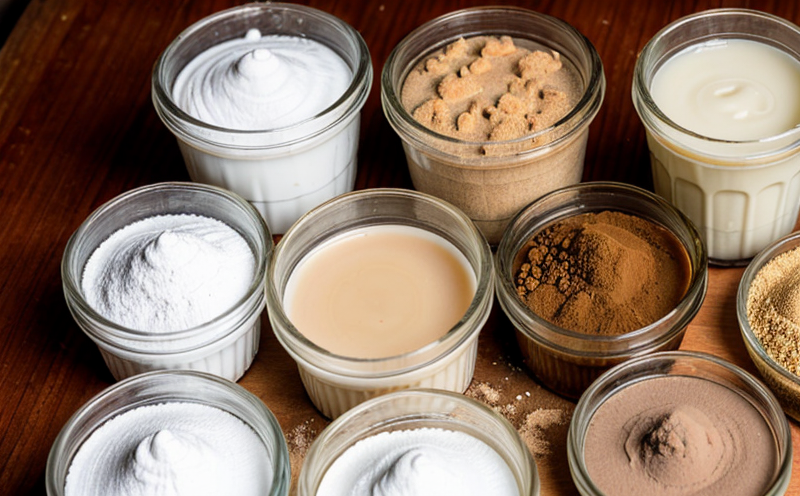ISO 21527-1 Enumeration of Yeasts and Molds in Food at 25°C
The enumeration of yeasts and molds is a crucial aspect of food safety. Yeast and mold can pose significant risks to human health, particularly for individuals with compromised immune systems or those who are sensitive to mycotoxins. ISO 21527-1 provides a standardized approach to the quantitative recovery of yeasts and molds from foods at 25°C, ensuring consistent results across different laboratories.
This method is widely used in quality management, compliance with regulatory standards, and research & development (R&D) activities related to food safety. For instance, it can help in monitoring the effectiveness of preservatives, optimizing processing conditions, or assessing the stability of products under various storage conditions.
The process involves several key steps:
- Sample collection: Fresh samples are collected from production lines and stored at 25°C ±1°C for up to 7 days before analysis. This ensures that the yeasts and molds remain viable during transport and short-term storage.
- Preparation: Samples undergo thorough preparation, including homogenization and dilution, ensuring an accurate representation of the original sample.
- Culture medium: A specific culture medium is used to promote the growth of yeasts and molds. This ensures that all microorganisms are identified accurately.
- Analysis: Cultures are incubated at 25°C ±1°C for up to 14 days, during which time any growth indicates the presence of yeast or mold colonies.
The procedure is designed to be rigorous and reproducible, making it a reliable tool for monitoring food safety. Compliance with ISO 21527-1 helps ensure that food products meet international standards and are safe for consumption.
Understanding the significance of this test in the context of quality management is essential. By adhering to these guidelines, businesses can maintain high standards of hygiene and quality control, thereby protecting consumer health and trust.
Eurolab Advantages
At Eurolab, we pride ourselves on providing comprehensive and reliable food testing services that meet the highest international standards. Our ISO 21527-1 enumeration of yeasts and molds in food at 25°C service is no exception. Here are some key advantages of choosing us:
- Expertise and Experience: Our team comprises highly skilled professionals with extensive experience in food safety analysis.
- State-of-the-Art Facilities: We operate cutting-edge laboratories equipped with the latest technology for accurate and precise testing.
- Rigorous Quality Control: Every test undergoes strict quality checks to ensure accuracy and reliability.
- Comprehensive Reporting: Our detailed reports provide clear insights into your food safety status, making it easier for you to take corrective actions if necessary.
We are committed to delivering services that exceed expectations. Whether you need routine testing or one-off assessments, Eurolab is your partner in ensuring the highest standards of food safety.
Why Choose This Test
The enumeration of yeasts and molds using ISO 21527-1 at 25°C offers several compelling reasons for its adoption. Here’s why it is a preferred choice:
Regulatory Compliance: Many countries have stringent regulations regarding the presence of yeast and mold in food products. Adhering to ISO standards ensures that your product complies with these regulations, thereby avoiding potential legal issues.
Risk Management: By identifying and quantifying yeasts and molds early on, you can take proactive measures to mitigate risks associated with their growth. This is particularly important in the case of spoilage or contamination, which could lead to product recalls and financial losses.
Quality Assurance: Consistent testing helps maintain high-quality standards throughout your production process. Regular monitoring ensures that any deviations from expected levels are addressed promptly, enhancing overall product quality.
R&D Support: For those involved in R&D activities, this test provides valuable data on the impact of various factors such as temperature, time, and processing methods on yeast and mold growth.
Patient Care: In healthcare settings where patients have compromised immune systems, food safety is paramount. Ensuring that food products are free from excessive levels of yeasts and molds can significantly reduce the risk of infections.
International Acceptance and Recognition
The ISO 21527-1 method enjoys widespread international acceptance across various countries, including:
- Australia: The Australian Food Standards Code mandates compliance with international standards for food safety.
- New Zealand: New Zealand’s Food Safety Regulations align closely with ISO guidelines.
- United States: The FDA and USDA recommend this standard as a best practice for food testing.
- European Union: EU directives require adherence to ISO standards for food safety.
The method is recognized by regulatory bodies worldwide, ensuring that results are accepted across borders. This international recognition enhances the global marketability of your products and provides assurance to consumers about product quality.





